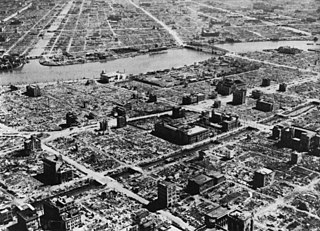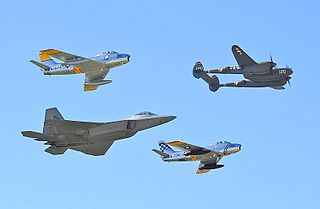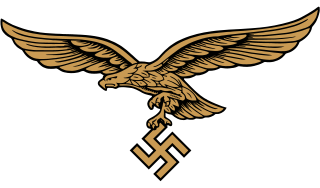
A night fighter is a fighter aircraft adapted for use at night or in other times of bad visibility. Night fighters began to be used in World War I and included types that were specifically modified to operate at night.

A strategic bomber is a medium to long range penetration bomber aircraft designed to drop large amounts of air-to-ground weaponry onto a distant target for the purposes of debilitating the enemy's capacity to wage war. Unlike tactical bombers, penetrators, fighter-bombers, and attack aircraft, which are used in air interdiction operations to attack enemy combatants and military equipment, strategic bombers are designed to fly into enemy territory to destroy strategic targets. In addition to strategic bombing, strategic bombers can be used for tactical missions. There are currently only two countries that operate strategic bombers: the United States and Russia.
Bomber Command is an organisational military unit, generally subordinate to the air force of a country. The most famous ones were in Britain and the United States. A Bomber Command is generally used for strategic bombing, and is composed of bombers.
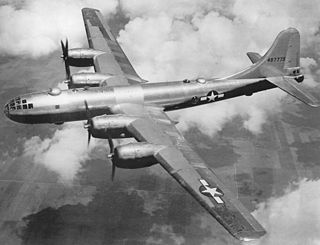
Heavy bombers are bomber aircraft capable of delivering the largest payload of air-to-ground weaponry and longest range of their era. Archetypal heavy bombers have therefore usually been among the largest and most powerful military aircraft at any point in time. In the second half of the 20th century, heavy bombers were largely superseded by strategic bombers, which were often smaller in size, but were capable of delivering nuclear weapons.

Strategic bombing during World War II was the sustained aerial attack on railways, harbours, cities, workers' and civilian housing, and industrial districts in enemy territory during World War II. Strategic bombing is a military strategy which is distinct from both close air support of ground forces and tactical air power.
The second Schweinfurt raid was a World War II air battle that took place on 14 October 1943, over Nazi Germany between forces of the United States 8th Air Force and German Luftwaffe fighter arm (Jagdwaffe). The American bombers conducted a strategic bombing raid on ball bearing factories to reduce production of these vital parts for all manner of war machines. This was the second attack on the factories at Schweinfurt. American wartime intelligence claimed the first Schweinfurt–Regensburg mission in August had reduced bearing production by 34 percent but had cost many bombers. A planned follow-up raid had to be postponed to rebuild American forces.

Berlin, the capital of Nazi Germany, was subject to 363 air raids during the Second World War. It was bombed by the RAF Bomber Command between 1940 and 1945, by the USAAF Eighth Air Force between 1943 and 1945, and the French Air Force between 1944 and 1945 as part of the Allied campaign of strategic bombing of Germany. It was also attacked by aircraft of the Red Air Force, especially in 1945 as Soviet forces closed on the city. British bombers dropped 45,517 tons of bombs; the Americans dropped 23,000 tons. As the bombings continued more and more people moved out. By May 1945, 1.7 million people had fled.

The Pointblank directive authorised the initiation of Operation Pointblank, the code name for the primary portion of the Allied Combined Bomber Offensive intended to cripple or destroy the German aircraft fighter strength, thus drawing it away from frontline operations and ensuring it would not be an obstacle to the invasion of Northwest Europe. The Pointblank directive of 14 June 1943 ordered RAF Bomber Command and the U.S. Eighth Air Force to bomb specific targets such as aircraft factories, and the order was confirmed when the Allies met at the Quebec Conference, 1943.
Big Week or Operation Argument was a sequence of raids by the United States Army Air Forces and RAF Bomber Command from 20 to 25 February 1944, as part of the European strategic bombing campaign against Nazi Germany. The planners intended to attack the German aircraft industry to lure the Luftwaffe into a decisive battle where the Luftwaffe could be damaged so badly that the Allies would achieve air superiority which would ensure success of the invasion of continental Europe.
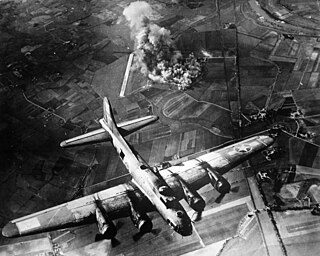
The Combined Bomber Offensive (CBO) was an Allied offensive of strategic bombing during World War II in Europe. The primary portion of the CBO was against Luftwaffe targets which was the highest priority from June 1943 to 1 April 1944. The subsequent highest priority campaigns were against V-weapon installations and petroleum, oil, and lubrication (POL) plants. Additional CBO targets included railyards and other transportation targets, particularly prior to the invasion of Normandy and, along with army equipment, in the final stages of the War in Europe.

The Defence of the Reich is the name given to the strategic defensive aerial campaign fought by the Luftwaffe over German-occupied Europe and Nazi Germany during World War II. Its aim was to prevent the destruction of German civilians, military and civil industries by the Western Allies. The day and night air battles over Germany during the war involved thousands of aircraft, units and aerial engagements to counter the Allied strategic bombing campaign. The campaign was one of the longest in the history of aerial warfare and with the Battle of the Atlantic and the Allied Blockade of Germany was the longest of the war. The Luftwaffe fighter force defended the airspace of German-occupied territory against attack, first by RAF Bomber Command and then against the United States Army Air Forces (USAAF).

Wilde Sau was the term given by the Luftwaffe to the tactic used from 1943 to 1944 during World War II by which British night bombers were engaged by single-seat day-fighter aircraft flying in the Defence of the Reich.
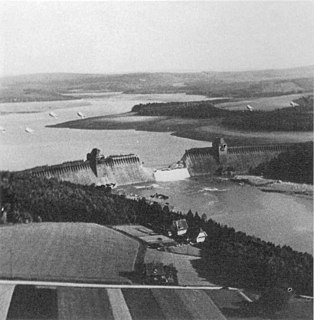
The Battle of the Ruhr of 1943 was a 5-month British campaign of strategic bombing during the Second World War against the Ruhr Area in Nazi Germany, which had coke plants, steelworks, and 10 synthetic oil plants. The campaign bombed 26 major Combined Bomber Offensive targets. The targets included the Krupp armament works (Essen), the Nordstern synthetic-oil plant (Gelsenkirchen), and the Rheinmetal–Borsig plant in Düsseldorf. The latter was safely evacuated during the Battle of the Ruhr.Although not strictly part of the Ruhr area, the battle of the Ruhr included other cities such as Cologne which were within the Rhine-Ruhr region and considered part of the same "industrial complex". Some targets were not sites of heavy industrial production but part of the production and movement of materiel.
The 330th Bombardment Group was a bomber group of the United States Army Air Forces during World War II. It was formed on 1 July 1942 at Salt Lake City Army Air Base, Utah. Initially, the group was equipped with the Consolidated B-24 Liberator, and served as a training unit within the United States until April 1944. On 1 April 1944, the group re-formed as a Boeing B-29 Superfortress-equipped unit as part of the 314th Bombardment Wing and trained for deployment to the Pacific Theater against Japan.

The air warfare of World War II was a major component in all theaters and, together with anti-aircraft warfare, consumed a large fraction of the industrial output of the major powers. Germany and Japan depended on air forces that were closely integrated with land and naval forces; the Axis powers downplayed the advantage of fleets of strategic bombers, and were late in appreciating the need to defend against Allied strategic bombing. By contrast, Britain and the United States took an approach that greatly emphasised strategic bombing, and tactical control of the battlefield by air, as well as adequate air defences. Both Britain and the U.S. built a strategic force of large, long-range bombers that could carry the air war to the enemy's homeland. Simultaneously, they built tactical air forces that could win air superiority over the battlefields, thereby giving vital assistance to ground troops. The U.S. and Royal Navy also built a powerful naval-air component based on aircraft carriers, as did Japan; these played the central role in the war at sea.

Poltava Air Base is a military airfield located approximately 8 km (5.0 mi) northwest of Poltava, Ukraine. It is one of two airfields near Poltava, the other being Poltava Airport.

On the night of 9/10 March 1945 the United States Army Air Forces (USAAF) conducted a devastating firebombing raid on Tokyo, the Japanese capital city. This attack was code-named Operation Meetinghouse by the USAAF and is known as the Great Tokyo Air Raid in Japan. Bombs dropped from 279 Boeing B-29 Superfortress heavy bombers burned out much of eastern Tokyo. More than 90,000 and possibly over 100,000 Japanese, mostly civilians, were killed and one million left homeless, making it the most destructive single air attack of World War II. The Japanese air and civil defenses proved inadequate, and only 14 American aircraft and 96 airmen were lost.





